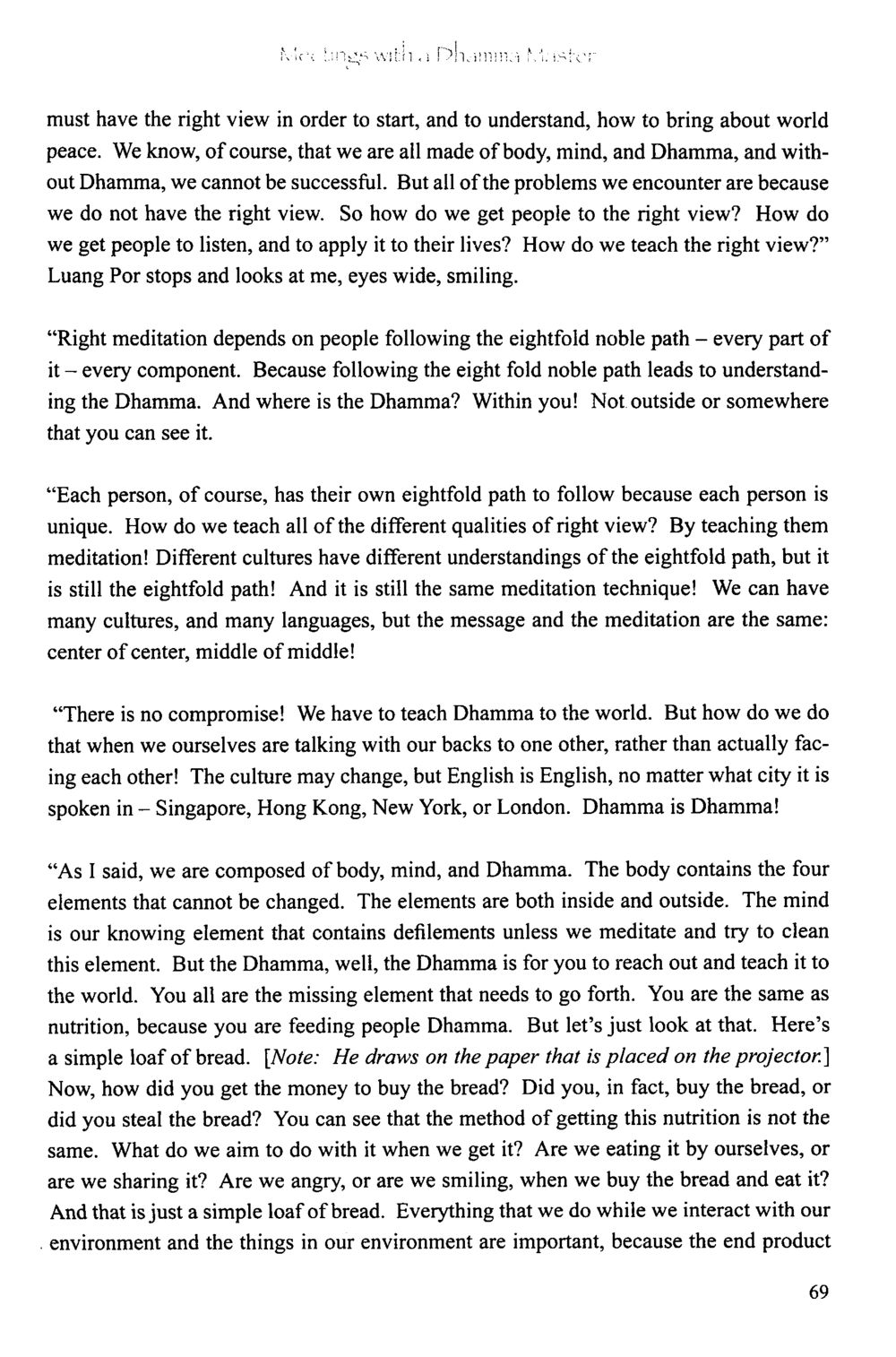The Path to Right View and World Peace : หน้า 72/164
The Meeting with a Dhamma Master : หน้า 72/164 Exploring the importance of the right view in achieving world peace through Dhamma and meditation practices.
5 ครั้ง

สรุปเนื้อหา
This text emphasizes the significance of the right view in attaining world peace, stating that Dhamma must be understood and implemented in one’s life. The essence of meditation tied to the eightfold noble path is highlighted, underscoring the individuality of each person's journey while emphasizing the universal nature of Dhamma. Cultural differences are acknowledged, yet the message remains constant. The text encourages sharing Dhamma with the world, likening it to sharing nutrition, showcasing the importance of intention and interaction in daily life.
หัวข้อประเด็น
-Right view and meditation
-The eightfold noble path
-Cultural interpretations of Dhamma
-The role of intention in actions
-Sharing Dhamma as nourishment
ข้อความต้นฉบับในหน้า
Nic Mush-wi. A Dhamma Master
must have the right view in order to start, and to understand, how to bring about world peace. We know, of course, that we are all made of body, mind, and Dhamma, and without Dhamma, we cannot be successful. But all of the problems we encounter are because we do not have the right view. So how do we get people to the right view? How do we get people to listen, and to apply it to their lives? How do we teach the right view?" Luang Por stops and looks at me, eyes wide, smiling.
"Right meditation depends on people following the eightfold noble path - every part of it - every component. Because following the eight fold noble path leads to understanding the Dhamma. And where is the Dhamma? Within you! Not outside or somewhere that you can see it.
"Each person, of course, has their own eightfold path to follow because each person is unique. How do we teach all of the different qualities of right view? By teaching them meditation! Different cultures have different understandings of the eightfold path, but it is still the eightfold path! And it is still the same meditation technique! We can have many cultures, and many languages, but the message and the meditation are the same: center of center, middle of middle!
"There is no compromise! We have to teach Dhamma to the world. But how do we do that when we ourselves are talking with our backs to one other, rather than actually facing each other! The culture may change, but English is English, no matter what city it is spoken in - Singapore, Hong Kong, New York, or London. Dhamma is Dhamma!
"As I said, we are composed of body, mind, and Dhamma. The body contains the four elements that cannot be changed. The elements are both inside and outside. The mind is our knowing element that contains defilements unless we meditate and try to clean this element. But the Dhamma, well, the Dhamma is for you to reach out and teach it to the world. You all are the missing element that needs to go forth. You are the same as nutrition, because you are feeding people Dhamma. But let's just look at that. Here's a simple loaf of bread. [Note: He draws on the paper that is placed on the projector.] Now, how did you get the money to buy the bread? Did you, in fact, buy the bread, or did you steal the bread? You can see that the method of getting this nutrition is not the same. What do we aim to do with it when we get it? Are we eating it by ourselves, or are we sharing it? Are we angry, or are we smiling, when we buy the bread and eat it? And that is just a simple loaf of bread. Everything that we do while we interact with our environment and the things in our environment are important, because the end product 69
หน้าหนังสือทั้งหมด

1

2

3

4

5

6

7

8

9

10

11

12

13

14

15

16

17

18

19

20

21

22

23

24

25

26

27

28

29

30

31

32

33

34

35

36

37

38

39

40

41

42

43

44

45

46

47

48

49

50

51

52

53

54

55

56

57

58

59

60

61

62

63

64

65

66

67

68

69

70

71

72

73

74

75

76

77

78

79

80

81

82

83

84

85

86

87

88

89

90

91

92

93

94

95

96

97

98

99

100

101

102

103

104

105

106

107

108

109

110

111

112

113

114

115

116

117

118

119

120

121

122

123

124

125

126

127

128

129

130

131

132

133

134

135

136

137

138

139

140

141

142

143

144

145

146

147

148

149

150

151

152

153

154

155

156

157

158

159

160

161

162

163

164
หนังสือที่เกี่ยวข้อง
Load More
